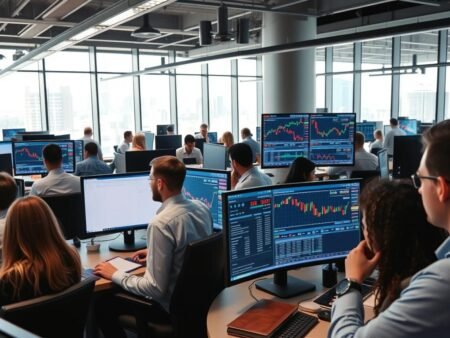Prop trading firms are a tough but rewarding place for traders around the world. The trading evaluation is a key test that shows who’s serious and who’s not. This article will guide you through the secrets and insights needed to pass a prop trading firm challenge on your first try. Getting this right can change your career in the fast-paced world of finance.
Prop trading firms look for people who can read market trends well and stay focused under pressure. The trading assessment is more than just making money. It checks your strategy, risk handling, and how you adapt. We’ll break down the challenge, so you can face your trading evaluation with confidence and knowledge.
Passing a prop trading firm test on the first try is tough. It needs careful planning, a solid trading plan, and a commitment to keep getting better. Join us as we prepare you with the skills to make your dream of becoming a prop trader a reality.
Key Takeaways
- Identify what prop trading firms look for in traders beyond mere profits.
- Understand the essential components and expectations of a trading evaluation.
- Gather tips and strategies to craft a comprehensive trading plan.
- Learn about vital performance metrics and targets set by prop firms.
- Discover the psychological nuances that can make or break success in trading assessments.
- Emphasize the importance of risk management and technical analysis techniques.
Understanding the Prop Trading Firm Environment
Prop trading firms focus on growing their own money through trading. Knowing what these firms want can really help a trader succeed.
What Prop Trading Firms Look For in a Trader
These firms look for traders who can analyze markets well and handle stress. They want traders who are:
- Decisive: Quick to make smart choices.
- Resilient: Can stay focused even when things go wrong.
- Adaptable: Can change strategies fast when the market changes.
Types of Prop Firm Challenges
Prop firms use challenges to test traders. These challenges can be:
- Time-based Challenges: Traders must show they can make money within a certain time.
- Profit Target Challenges: Traders aim to meet or beat a profit goal to move forward.
The Mindset Required for Success
To succeed in prop trading, it’s not just about knowing how to trade. A good mindset is key. Important mental qualities include:
- Risk Tolerance: Knowing how to handle the risks of aggressive trading.
- Emotional Stability: Staying calm when things get tough.
- Continuous Learning: Always learning and improving to keep up with the market.
To be a top prop trader, you need to understand trading well and be ready for tough challenges. Being well-prepared and having the right mindset can help you succeed in this competitive field.
Exploring Prop Trading Firm Secrets for Success
Prop trading firms offer many chances for skilled traders. Knowing the prop trading firm secrets is key to success. These secrets help traders meet and beat trading evaluation standards, leading to a strong trading career.
Mastering the firm’s trading evaluation criteria is a top strategy. Each firm has its own benchmarks and goals. Understanding these criteria is crucial for success:
- Adherence to Risk Management: Learning the firm’s risk limits helps avoid big mistakes.
- Profit Targets: Knowing the firm’s profit goals helps tailor your strategies.
- Trading Style Compatibility: Matching your trading style with the firm’s can boost your chances of passing the trading evaluation.
Many new traders overlook the psychological side of trading with a firm. The high-pressure environment requires a strong mindset. Experienced traders suggest:
Building mental resilience through coaching and reviews improves decision-making under pressure, crucial for prop trading success.
Being able to adapt to changing markets is also key. Prop trading firms want traders who can handle different market conditions. This means always learning and being flexible—a secret and a must for prop firm success.
Learning these insider strategies and applying them can greatly improve your chances of success. Ready to explore more about prop trading? Check out resources that offer deep insights and the latest on the prop trading world.
Getting to Know the Trading Evaluation Parameters
Before a prop trading test, it’s key to know the main evaluation parameters. These help firms see if a trader can make money in the markets. By getting these metrics, traders can shape their plans to hit the marks set by these programs.
Key Performance Metrics Used by Prop Firms
Prop trading firms use many metrics to check traders. Here are some:
- Profit and Loss (P&L): Shows how much money a trader makes or loses.
- Sharpe Ratio: Looks at the return on risk, showing how much extra return a trader gets for the risk taken.
- Maximum Drawdown: The biggest drop in value, showing the highest risk taken.
- Consistency of Returns: Checks if a trader can keep making profits over time.
These metrics help firms see how well a trader does and manages risk. This is very important in the world of prop trading.
Common Rules and Targets in Trading Assessments
In a prop trading test, there are specific rules and targets. These mimic the real trading world. Key rules include:
- Daily and monthly loss limits to keep risk low.
- Minimum profit targets to grow capital.
- Risk-reward ratios for smart trading decisions.
- Trading hours to show discipline.
Meeting these targets shows a trader’s skill in strategy and discipline. This is very important in prop trading.
Creating a Solid Trading Plan
Creating a solid trading plan is key for traders aiming to succeed in a trading challenge. This plan is more than a guide through the markets. It aligns your trading strategies with the firm’s criteria. Here’s how to build a strong trading plan:
- Analyze Historical Data: Look at past market trends and your trading history. This helps spot patterns for better decision-making.
- Define Your Trading Goals: Determine if you want to grow your capital or keep it safe. Set specific, achievable goals.
- Develop Risk Management Rules: Decide on stop loss and take profit levels. Also, decide how much of your portfolio to risk in one trade.
- Select Your Trading Style: Choose between day trading, swing trading, or another style. Your style affects your trading pace and approach.
- Use Technology to Your Advantage: Use tools and software to automate and refine your trades.
Here’s a table showing what your trading plan should include for a trading challenge.
| Aspect | Importance | Examples |
|---|---|---|
| Risk Management | High | 1% risk per trade, Stop loss at 15 pips |
| Trade Selection | Medium | Focus on EUR/USD, Gold |
| Profit Targets | Medium | Target 2% growth per week |
| Review Period | High | Weekly trade performance review |
When making your trading plan for a trading challenge, use flexible methods. These should adjust to market changes. A good plan outlines what to trade and how much. It also prepares you for surprises.
Essential Strategies for Financial Trading
Effective financial trading strategies and strong risk management are key in the fast-paced world of prop trading. Learning these methods boosts traders’ skills and helps them stay strong against market ups and downs.
Technical Analysis Techniques
Technical analysis is a mainstay in trading, using past price data and stats to forecast market trends. Traders use tools like moving averages, RSI, and MACD to guide their decisions.
Risk Management Fundamentals
Risk management is vital to avoid losses and improve financial results. It involves setting stop-loss orders, controlling trade sizes, and analyzing scenarios to protect against market drops. Knowing these basics helps traders keep their investments safe in different market situations.

Using these advanced tools and strategies daily can greatly improve your trading success. Here’s a closer look at how top traders balance their portfolios:
| Strategy | Application | Expected Result |
|---|---|---|
| Moving Averages | Identify trends | Improves entry and exit points |
| RSI and MACD | Determine overbought or oversold conditions | Timely trades based on market sentiment |
| Stop-Loss Orders | Limit losses | Preserves capital during downturns |
| Position Sizing | Manage the exposure of a trade | Balances the portfolio risk |
By deeply understanding and applying these trading strategies and risk management practices, traders can boost their profits while managing risk well. This is the foundation of a successful trading career.
Practical Tips to Improve Trading Performance
Getting better at trading means using time management and continuous learning wisely. These are key for those wanting to do well in trading.
Time Management for Traders
Using time well is key to trading success. Traders who manage their time well can tackle market chances and challenges better. Here are some tips:
- Plan your trading around when the market is most active to make the most of it.
- Set aside specific times for market research and analysis to avoid over-trading and getting tired.
- Use calendars and reminders to keep track of important economic events and earnings announcements that affect the market.
Continuous Learning and Adaptation
The trading world is always changing, so learning never stops. Taking an educational approach can really help improve your trading:
- Take part in webinars, courses, and read the latest financial news to stay current.
- Try out new trading strategies on a small scale to see if they work without big risks.
- Regularly look back at your trades and market trends to learn and adjust your strategies.
By adding these strategies to your daily trading routine, you can better manage your time and keep learning. These steps are crucial for anyone wanting to boost their trading skills and make money in the long run.
How to Pass a Prop Firm Challenge on Your First Try
To pass a prop firm challenge on your first try, you need to know the trading assessment process well. It’s also important to understand the key practices in prop trading firms. This summary will remind you of the essential strategies to overcome these challenges.
For success, focus on a balanced approach. This includes creating a detailed trading plan, following risk management rules, and improving your technical analysis skills. Here’s a quick guide to help you prepare:
- Know what the prop trading firm’s trading assessment requires and what it aims to test.
- Make a strong trading strategy that fits the firm’s rules and uses your strengths well.
- Practice a lot with trading simulators to get used to real market conditions.
- Keep your emotions in check during trading to stay focused and make clear decisions.
Remember, each prop trading firm has its own criteria. So, make sure your preparation matches their specific expectations.
| Component | Description | Relevance to Challenge |
|---|---|---|
| Trading Plan | Detailed blueprint of trading activities | Essential for structured and disciplined trading |
| Market Analysis | Technical and fundamental review of market conditions | Crucial for making informed trading decisions |
| Risk Management | Strategies to preserve capital and manage losses | Key to sustaining in the trading assessment long-term |
| Psychological Preparedness | Mental strategies to handle trading pressures | Impactful for maintaining composure and focus |
By combining these elements well, you’ll be better prepared to pass a prop firm challenge on your first try. Success depends not just on knowing trading strategies. It also requires fitting into the unique culture and rules of your chosen prop trading firm.
Navigating the Psychological Aspects of Trading Assessments
Understanding the psychological side of trading is key to reaching your full potential. It’s about handling trading pressure, keeping your confidence up, and doing well in tough situations. These skills are crucial for success in high-pressure trading environments.
Dealing with Pressure and Anxiety
Even seasoned traders can feel overwhelmed by trading pressure. To cope, set achievable goals, focus on the process, not just profits. Also, practice mental exercises like mindfulness or meditation regularly.
“The ability to detach from emotions during high pressure is what differentiates a successful trader from the rest.”
Using psychological trading assessments can help you understand what triggers your anxiety. This way, you can better prepare to handle it.
Building Confidence as a Prop Trader
Confidence is vital for prop traders to thrive. It’s not just about winning trades. It’s also about knowing the market well and bouncing back from losses.
- Regular review of trading journals
- Participation in trading simulations
- Continuous learning and skills enhancement
These habits help you make better decisions. This boosts your confidence over time.
| Factor | Impact on Trading Pressure | Influence on Trader Confidence |
|---|---|---|
| Market Volatility | High | Moderate |
| Personal Performance History | Moderate | High |
| Risk Management Skills | Low | High |
| Support Network | Low | Moderate |
Note: Understanding these factors well helps manage emotions and expectations during trading assessments.
Effective Use of Trading Simulators in Preparation
Aspiring traders can improve their skills by using trading simulators. These tools create a real trading environment. They let people practice their analysis and decision-making without risking real money.
Trading simulators are key for getting ready for trading challenges. They show the real complexity of financial markets. Traders can try out different strategies and learn to handle quick market changes.
These simulators also have features like those in professional trading platforms. This helps users get used to the tools they’ll use in real trading.
- Understanding market dynamics
- Testing trading strategies
- Building confidence without financial risk
Using trading simulators also helps with mental preparation for trading. This is as important as knowing the technical side. Regular practice on these platforms makes traders more resilient against the stress and emotional ups and downs of real trading.
In short, trading simulators are very helpful in getting ready for trading challenges. They give traders the skills and confidence they need to do well in real trading situations.
Setting Realistic Goals for Your Prop Trading Test
Setting realistic trading goals is key for anyone getting ready for a prop trading test. It’s important to balance short-term wins with long-term goals. This helps shape a trader’s career path.
This section talks about matching prop trading test objectives with what you can do and the market’s conditions.
Short-term Vs Long-term Objectives
Short-term goals are about hitting specific, measurable targets. These can be daily or weekly profits, better win-to-loss ratios, or learning new strategies.
Long-term goals might be about being a profitable trader for years, growing your trading size wisely, or starting a trading desk. The goal is to set these targets high but reachable, promoting steady growth and learning.
Understanding Trade Scaling
Trade scaling means adjusting trade sizes based on performance and market analysis. It’s key for reaching both short-term and long-term goals. It helps traders make the most of their wins and manage risks during tough times.
Here’s how trade scaling helps in growing without too much risk:
- Progressive Difficulty: Scaling lets traders grow their trade sizes as they get better, matching their skill and confidence.
- Risk Management: Adjusting trade sizes helps manage risk based on how confident traders are in their trades.
- Capital Efficiency: Using capital wisely means not risking too much at any time, which is vital in unpredictable markets.

Having clear, realistic trading goals and grasping trade scaling is crucial for prop trading success. These strategies are not just about hitting targets but also about growing and staying stable in a trading career.
Mitigating Risks during the Trading Challenge
Risk mitigation is key, especially in trading challenges. This part talks about how to manage and reduce risks. It helps traders keep their money safe while aiming for their goals.
Knowing and using good risk management can change how well you do in a trading challenge. We’ll look at ways to keep your investments safe during these tough times.
- Establish Risk Limits: Decide how much money you can lose on one trade. Stick to this to avoid making rash decisions when the market is shaky.
- Use Stop-Loss Orders: Stop-loss orders are crucial for keeping your money safe. They prevent big losses. Place them wisely based on your risk level and market analysis.
- Diversify Trade Selection: Don’t put all your eggs in one basket. Spread your money across different trades. This way, you’re protected from big losses.
- Continuous Market Monitoring: Keep up with market news and trends. This helps you adjust your plans quickly.
- Maintain Discipline: Stick to your trading plan, even when the market tries to tempt you. This keeps you focused on your long-term goals and controls risks.
Also, using real-time simulators can improve your trading and risk management. Practicing in a controlled setting helps you get used to fast market changes. It boosts your confidence and sharpens your decision-making skills.
In short, managing risks well in a trading challenge is not just about keeping gains. It’s also about knowing and preparing for potential problems.
Reviewing Past Trading Performance for Improvement
Getting better at trading means looking back at what you’ve done. A detailed review of your trading helps spot patterns, good and bad. This helps refine your strategies and keeps your trading career growing.
Analyzing Your Winning and Losing Trades
It’s key to understand both your wins and losses. By seeing what worked and what didn’t, you can make your strategies better. Look at when you entered and exited trades, the market conditions, and if you followed your plan.
Learning from Prop Trading Firm Feedback
Feedback from prop trading firms is very valuable. They offer insights on managing risk, making decisions, and following rules. Using their advice can greatly improve your trading skills.
| Aspect | Importance in Trading Performance Review | Role of Prop Firm Feedback |
|---|---|---|
| Strategy Evaluation | Essential for identifying strong and weak points in trading approaches. | Provides targeted advice to refine strategies based on real market data. |
| Risk Management | Crucial for long-term sustainability in the market. | Feedback often includes insights on improving risk profiles and loss mitigation techniques. |
| Performance Metrics | Necessary for measuring trading efficiency and progress. | Enables traders to align their performance metrics with market expectations and firm standards. |
Utilizing Educational Resources from the Prop Firm
The availability of prop firm educational resources can greatly change how a trader approaches the trading assessment. Learning how to use these tools can improve your trading skills. It also helps you make better strategic decisions, which is key to success in trading.
Many traders don’t realize the wealth of resources prop firms offer. These include webinars, e-books, and trading simulations. These tools provide both basic and advanced trading knowledge.
- Webinars cover topics like risk management and market analysis.
- E-books offer insights into effective trading methods for different markets.
- Trading simulations let you practice without risking money, using real market data.
To get the most out of these prop firm educational resources, you need a plan. This plan should match your learning style and trading goals. Here’s a good way to use these resources for your trading assessment:
| Resource Type | Usage Strategy | Expected Outcome |
|---|---|---|
| Webinars | Attend live sessions and ask questions to clear up doubts. | Gain a better understanding of real markets and improve strategy. |
| E-books | Read each chapter carefully and apply what you learn in simulated trades. | Learn specific trading strategies and principles in depth. |
| Simulations | Practice regularly, then review your trades and adjust your strategies. | Get faster and more accurate in making decisions during live trades. |
By using these educational tools regularly, you’ll get much better at the trading assessment. This will help you trade with more confidence and strategy. The goal is not just to pass the assessment. It’s to keep improving your trading skills all the time.
Why Continuous Practice Is Key to Becoming a Successful Prop Trader
In the world of proprietary trading, ‘practice makes perfect’ is more than a saying. It’s a key principle for success. To master complex markets, you need more than just book knowledge. A strong daily trading routine that supports continuous trading practice is essential.
The Importance of Daily Trading Routine
Having a daily trading routine is vital for prop trading success. It should include market analysis, trading, and review sessions. This way, each day helps you grow and get better at trading.
This routine keeps you disciplined and consistent, which is crucial for long-term success. Daily market analysis sharpens your strategic skills. It keeps you updated on market movements and indicators that affect your trading decisions.
How Consistency Leads to Mastery
Consistency in trading is not just about showing up. It’s about sticking to your trading plan and learning from each session. This cycle of practice, learning, and application is key to trading mastery.
Regular trading helps you develop analytical skills. You learn to closely watch market trends and your own performance. This deep analysis helps you improve your strategies, reduce errors, and increase profits.
The path to prop trading success is paved with persistence, discipline, and a drive for improvement. Whether you’re new or experienced, a structured trading routine is crucial.
Stick to your routine, and your hard work will pay off. You’ll master the trading charts.
Preparing for the Unexpected: Dealing with Market Volatility
Market volatility is a big challenge in financial trading, especially for prop trading firms. It brings both opportunities and risks. Traders need effective strategies to handle these changes.
Understanding market movements and adjusting strategies quickly is key. This helps traders manage risks and make the most of opportunities.
Adaptive risk management is crucial for dealing with volatility. It helps traders protect their gains and avoid big losses. Preparation includes knowing how to set stop-loss orders and understanding leverage.
For more tips, traders can check out trading news platforms. They offer the latest advice on handling market ups and downs.
To succeed in a prop trading firm challenge, traders need knowledge, skill, and discipline. They should also control their emotions and stay focused during market turmoil. A well-planned strategy that includes news events and adaptable trading can help traders perform well.












